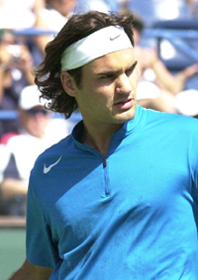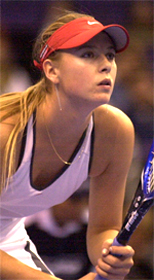Your Temperament
and Your Tennis
Dexter GodbeyPage 2
Jimmy Connors is a classic example of a Blue. The bigger the stage the better he played, and the more he enjoyed it. Although known for his flat, penetrating groundstrokes, Connors always mixed in judicious net approaches, often coming up with winning volleys at critical times. Early in his career he frequently played serve and volley tennis at Wimbledon. Connors developed a work ethic very early in his career, coming from his mother Gloria. Interestingly, he never believed in practicing more than an hour to an hour and a half. But his practice was extremely focused and intense. This is a great Blue strategy.
Serena Williams is a Blue example from the women's side. Unlike her sister, Serena thrives in the spotlight and plays an all around game combining, power, athleticism, and a love of drama. Her focus on tennis fashion, the unending stream of new outfits, combined with her fascination with Hollywood and superstardom in general are all more examples of her temperament.
Rafael Nadal also has the characteristics of the Blue player. Clearly he thrives in big matches in big tournaments. His technical game is very creative. Unlike other players with similar grips, Nadal hits a high percentage of his forehands with reverse finishes with the racket staying on his left side. This allows him to generate incredible spins from anywhere on the court. More than likely this was something he developed intuitively on his own, as it not a staple in coaching, even in the Spanish topspin tradition. Although he plays from well behind the baseline, Nadal is not afraid to come forward. He occasionally hits winning volleys at critical times, as well as drop shots and his incredible angles.
Green Temperament
Basic Prevailing Wants: Order, Progress, Accuracy, Thoroughness
Motto: "I Do It The Right Way"
Characteristics:
|
|
Analytical |
Must Be "Right" |
Calm |
Perfectionist |
Disciplined |
Problem Solver |
Logical |
Self Disciplined |
Loves:
|
Hates:
|
Independence |
Criticism |
Order |
Disorganization |
Plans |
Embarrassment |
Problem Solving |
Unpredictability |
Strengths:
|
Areas For Improvement:
|
Analyzing |
Analysis Paralysis |
Discipline |
Overly Critical |
Planning/Organizing |
Private To A Fault |
Problem Solving |
Stubborn To a Fault |
You are a thinker, analyzer, and problem solver. You are also patient and love plans, discipline, and routine. Like the Blues, your temperament probably does best with an all court game but for different reasons. You like it so you can problem solve. You like to think your way through matches.
You will always have a plan to maximize your strengths and minimize your weaknesses while playing high percentage tennis. You will try to execute your plan with as much patience and precision as possible because you're a perfectionist.
But, if your plan isn't working, you will analyze why not, figure out how to improve it, and revise it. And, if the new plan isn't working, you'll go through the same analysis-correction process again, until you get it "right." To you, tennis is an analytical problem solving exercise. You work hard to develop all the shots because you need enough game to execute all variety of plans.
Because of your patience, self-discipline, and perfectionism, you're able to practice and drill as long and hard as it takes. And, since you like being alone, you're just as happy to practice against a wall, backboard, or ball machine as you are to practice with other people.
Unlike the Yellows and Blues, you learn and will build your game from the detailed, technical, mechanical elements up -- from the details up to the whole. You will watch the videos in the Stroke Archive frame-by-frame over and over again, analyzing every nuance and figuring out how to incorporate what you learn into your game.
You prefer a long, structured, thorough warm up. You want to get that groove going so you're hitting "perfect" shots as much as possible from the first serve on. You have a set routine you go through in your warm ups and won't want to vary it. It gives you a sense of security and is all part of your plan.
Roger Federer is the epitome of a Green player. No one has his incredible variety of shots. And this gives him seemingly unlimited strategic options. Read the Federer forehand article by John Yandell to see what he can do, just on that side. (Click Here.)
In a recent interview, Roger talked about working to continue to improve his volley. He noted as an aside that he felt he had a very complete understanding of tactics and how to vary them. What he was doing was improving the techniques to implement them.
In this vein hea made some revealing comments about serving and volleying. He said that he loved to serve and volley, but that to do it as a regular tactic requires a great serve. His assessment was that his own serve was "good" but not great. No doubt he saw improving his volley as a way to compensate for that and develop yet more options at certain times against certain opponents. It's a classic Green example of knowing exactly what capabilities you have and then applying them at the right time in matches
Monica Seles once said her dream was to play a perfect match with no errors. No errors! That's the kind of perfection Green temperaments seek. At Bollettieri's Monica was renowned for her love of marathon practice sessions. And look at Martina Hingis and her recent comeback. She has always been known as a thinking player who used her variety to throw opponents off both physically and mentally. Now a more mature 25 year old, her strategic thinking may be reaching yet another level as she accepts her own strengths and weaknesses.
Red Temperament
Basic Prevailing Wants:: Achievement, Competition, Control, Winning
Motto: "I Do It My Way"
Characteristics:
|
|
Competitive |
Impatient |
Confident |
Multi-Tasker |
Controlling |
Results Oriented |
Focused |
Risk Taker |
Loves:
|
Hates:
|
Challenges |
Idleness |
Competition |
Indecision |
Control |
Laziness |
Winning |
Losing |
Strengths:
|
Areas For Improvement: |
Confidence |
Difficult to Coach |
Determination |
Temper Can Boil Over |
Fearlessness |
Too Demanding |
Self Determined |
Too Impatient |
Your nature makes you the most aggressive and competitive of the temperaments. You love competition, being in control, winning, risk taking, and you are very impatient.
Your temperament lends itself to an aggressive, fast, high risk, do or die style of play -- either from the forecourt or backcourt. It doesn't matter which, as long as you feel like you are the aggressor, in control, and dictating play. You are likely to hit more winners and commit more errors than the other temperaments because you like to go for high risk, dominating, winning shots.
You'll have a specific plan and you'll stick with it. Unlike the Greens who will change their plans to solve problems or the Blues who will deviate from their plans just because their intuition will take over, you are unlikely to change your plan. Like the Yellows, your plan will be simple: Dominate your opponent and control the match (either from the baseline or net, whichever is your preference).
Even if your plan isn't going too well, you'll keep pounding away with your preferred style believing that you'll eventually wear down your opponent under your constant, aggressive pressure. You don't mind practicing, but you're impatient, a multi-tasker, and will always have other things to do and other things on your mind, so you'll prefer shorter practice sessions with specific purposes, well defined goals, and no wasted time.
Like the Greens, you learn through details and mechanics and will build your game from the technical side up. But you don't have nearly the patience of the Green temperaments, so you'll look for short-cuts and try to find ways to get to the bottom line quickly. You typically believe you know everything already, so you'll watch the Stroke Archive videos frame-by-frame, but only until you see what you already know (in your own mind at least). If it reinforces the way you want your game to be, you'll grab it, and then move on quickly to something else.
When you warm up you can go either way, long or short. If you're working on something in particular and want to use the warm up to achieve it, a longer warm up may suit you. Other times you may prefer to keep the warm up shorter and just get on with the match. You're not stuck on any specific routine like the Greens. You want to control the warm up for your maximum benefit, for example, taking a look at your opponent's strokes.
 |
 |
 |
Blue, Yellow, Red--can your recognize temperament in the top players? |
||
As a Red player you have to remember that in tennis matches you cannot control every single point and every single opponent you face. Be careful to not let that frustrate you too much. When your normal aggressive style isn't working in a given situation, you may need to go to Plan B. But, most likely, you don't have a Plan B. If you develop one it could help you win more.
The classic example on the pro tour of a Red player would be Taylor Dent. Taylor is relentless attacker, with some of the best volleys in the game, and a go for broke mentality. His history with coaches is also pure Red. I've known Taylor personally for a few years and let's just say he has his own opinions about what's best for his game, and therefore, he has gone through a number of coaches who may have had different thoughts. You can see another Red characteristic is his up and down (currently up) battle with his physical fitness and all the regular work that takes. Emotional on the court, his temper can flair, costing him focus, another Red characteristic.
Some of the great players in tennis history have also been primarily Red. No one ever did it his way more than the great John McEnroe. His temper was legendary as was his impatience with the press and others whose views his didn't respect. Interestingly however, John could also solicit and take input at times when he felt it was in his best interest, as when he straightened out his serve motion in the early 1990's working with John Yandell (Click Here.)
Martina Navratilova and Boris Becker were two more great Red champions. Although Becker played serve and volley at Wimbledon, he stubbornly insisted on trying to dominate from the backcourt on hardcourts, apparently based on the need to prove he was better than his opponent everywhere on the court.
Not all Red players are serve and volleyers. We can see in the case of Maria Sharapova, probably the most intense and driven player on either tour. Her fearlessness and determination are pure Red, as is her fist pumping after almost every winning point. As we noted, some top players are mix Red into their temperament, like Lleyton Hewitt. Lleyton's counterpunching backcourt game is Yellow, but his famous intensity and pugnacity are clearly Red.
Your Temperament and Your Tennis
One of the key elements to reaching your maximum tennis potential is to play, practice and learn in ways that are in tune with your temperament. Nick Saviano writes in his book Maximum Tennis: "Be true to yourself and develop a style of play consistent with your personality. That sounds like an obvious point but really it is not. Sometimes even players at the professional level lose their way when it comes to playing the right strategy." (Click Here to read Nick's articles on Tennisplayer.)
It would be crazy for the fearless, aggressive Maria Sharapova to try to play like the patient, defensive Arantxa Sanchez-Vicario. If pros tried to develop games that were "unnatural" to them they would be not reach their full potential. The differences in the temperaments may also mean that an emotional outburst on the court can be a positive for some players, and the opposite a signal that their games are beginning to come apart.
Yet, how many juniors, seniors, high school and college players, weekend warriors, and club players try to play the way they think they are "supposed" to play? Why does this happen? It can be the influence of well meaning coaches, parents, or teachers. Or players are trying to play a style like their favorite ATP or WTA pro. When you try to play a game that is contrary to your nature, you don't give yourself the chance to play your best e and enjoy your tennis as much as possible.
I found this out myself the hard way. I was taught to play an unrelenting serve and volley style, most characteristic of the Red temperament. My true temperament though is Green. My success in the seniors and my national ranking are a result of adjusting my playing style to my temperament. Rather than blindly charging ahead, I began to think through situations in matches and started to enjoy using my analytic skills to make tactical adjustments. The result was I played a more varied and all court game.
Just playing according to your temperament is of course no guarantee of success. Every temperament has strengths and weaknesses. No one temperament is better for winning matches. All other things being equal, every temperament can win against the other temperaments. At times player may find they need to play a style that actually goes against their temperament to win a particular match, although in the long run this may contribute to potential burnout.
This is because there are too many other factors involved: physical attributes, speed, quickness, athletic ability, anticipation, hand-eye coordination, strength, conditioning, stamina, plus intangibles like strength of will. But if you understand and embrace your true dominant temperament and learn to be true to yourself within your physical capabilities, you will have an edge and you'll be more likely to enjoy every minute you devote to playing, and even to thinking about your game.




